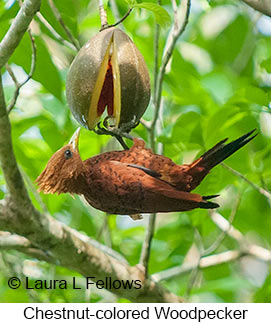BELIZE BIRDING TRIP REPORT

TRIP REPORT
BELIZE
| Start: | 01/08/2008 |
| End: | 01/18/2008 |
| Duration: | 11 days |
| #Species: | 276 |
| #Endemics: | 0 |
| #Heard Only: | 25 |
2008 Belize & Tikal Birding Tour
TOUR DESCRIPTION
Our 2008 birding tour to Belize and Tikal was led by H. Lee Jones, author of the Field Guides of the Birds of Belize, and Wilfred Requena who did the driving and is also a superb birding guide. The tour was a grand success. We saw or heard 277 species of birds, which included one species seen near the airport prior to tour departure and not seen later on the tour. In addition, tour participants spent 3 days on Caye Caulker prior to the tour and saw several additional species not included in the tour list, including Caribbean Elaenia and Black Catbird.
The tour began with a drive along the Western Highway and then southward from Georgetown on a dirt road to lovely Hidden Valley Inn. Certainly one of the big highlights of our visit was a fantastic look at an Orange-breasted Falcon at King Vulture Falls. One of us first spotted the bird flying just below the canyon rim close to the canyon wall. Wilfred walked up the canyon a bit and found the falcon perched in a tree not 100 ft from us. We enjoyed watching and photographing the bird for some 20 minutes before it finally flew. At the same location we also saw 6 adult and one juvenile King Vultures soaring in the canyon and even across the face of the falls. Far in the distance we saw a White Hawk soaring and heard Spotted Wood-Quail calling.
During our two day stay at Hidden Valley, we spent considerable time and effort looking for a Stygian Owl day roost. We've seen this bird on prior visits but failed to find it this year despite our efforts as well as the assistance of the resident guide who showed us areas where he can find the owl 90% of the time.
Other notable species we saw at Hidden Valley included Azure-crowned Hummingbird, Plain Wren, Black-headed Siskin, Rufous-capped Warbler, Rusty Sparrow, and Yellow-backed Oriole.
From Hidden Valley we continued west, crossing the border into Guatemala, and ultimately to Tikal Archaeological Site. En route we stopped at a wetland where we enjoyed nice views of a variety of widely distributed water birds. It was a nice stop that gave us a chance to stretch our legs while looking at a variety of herons and egrets, Northern Jacanas, Limpkins, and other species.
Tikal features some spectacular Mayan ruins from a bygone era when the residents fought several wars with the nearby Mayans from Caracol. It also features some spectacular birding. We again had wonderful views of Orange-breasted Falcon when a pair perched in a tree near Mundo Perdido. We had excellent looks at Ocellated Turkey an incredibly ornate species that is essentially tame at Tikal because it is no longer hunted by anyone. Other notable birds we saw at Tikal included Blue Ground-Dove, Brown-hooded Parrot, Lesser Swallow-tailed Swift, Canivet's Emerald, Purple-crowned Fairy, Tawny-winged and Ruddy Woodcreepers, Sepia-capped Flycatcher, Northern Royal Flycatcher, Tawny-crowned Greenlet, Black-headed Shrike-Tanager, and Blue Bunting.
After spending 3 days at Tikal, we crossed back into Belize and drove south along the Hummingbird Highway and then Southern Highway. Our next destination was Mama Noot's Backabush Lodge adjacent to Mayflower Bocawina National Park.
Mama Noot's serves arguably the best food in Belize, and we enjoyed their fine cooking to the fullest extent. We also enjoyed birding in Mayflower Bocawina as well as nearby Cockscomb Basin Jaguar Reserve. We saw some fresh Jaguar tracks but as usual no actual Jaguars. In Mayflower-Bocawina we were treated to spectacular views of a perched Double-toothed Kite, an extraordinary event that Lee Jones has experienced perhaps only twice before in Belize. We had great looks at a male White-collared Manakin perched just off the trail, and heard a calling Little Tinamou very near the trail but nonetheless never in view. We searched diligently for singing Black-faced Antthrush on two occasions but could never lure the bird into the open. We went owling one night and heard a Spectacled Owl without ever seeing it but had excellent views of a Black-and-white Owl perched not far from the lodge.
Other notable birds we saw in Mayflower-Bocawina National Park and Cockscomb Basin included Scaly-breasted Hummingbird, Wedge-tailed Sabrewing, Rufous-breasted Spinetail, Slate-headed Tody-Tyrant, Sulphur-rumped Flycatcher, Black-crowned Tityra, Golden-hooded Tanager, and Orange-billed Sparrow.
After departing Mama Noot's we drove back north, stopping for a morning of birding in Blue-hole National Park. The upper trail in the park is quite steep so only part of our group went up it. Since we had two guides, half the group stayed behind to bird the lower trail. Our major target bird was the Tody Motmot, and those of us who went on the upper trail had the good fortune of seeing this rare bird perched just off the trail. We heard it singing back in the forest, but the bird immediately responded to a single playback and flew right over our heads, only to disappear among the trees on the other side where it perched singing. It's song is so muted that the bird sounded farther away than it was, but one of our sharp-eyed participants spotted it perched just 30 ft away. Farther along the trail, we spotted a Rufous Mourner fly into the canopy over our heads. This cryptic bird is often heard but very difficult to actually see. We also had great looks at Rufous-tailed Jacamar, our only look at this secretive bird during the tour.
From Blue Hole we continued on to our last destination on the tour, Crooked Tree Wildlife Sanctuary. The main attraction at Crooked Tree is the wetlands and lagoon surrounding the village, where water birds often abound. The water levels in January are generally too high for many species, so birds that are quite common later in the year were quite scarce during January. Certainly one bird we wanted to see was the spectacular Jabiru, and Lee found a nest for us thanks to the excellent directions Nan gave us at Mama Noot's. When we arrived, one bird was standing on the nest while the other was sitting on eggs. It was changeover time, which gave us great views of a departing Jabiru as it flew from the nest.
A highlight of our stays at Crooked Tree is always our early morning boat trip on the lagoon. Among the species seen were Boat-billed Heron, Bare-throated Tiger-Heron, Great Black-Hawk, Gray-necked Wood-Rail, Gull-billed Tern, a wayward Forster's Tern, a couple Snail Kites, and several Black-collared Hawks. Crooked Tree is home to several Yucatan endemics, and we spent some time around the island looking for them. We had the good fortune of seeing Yucatan Woodpecker from the boat and several groups of Yucatan Jay. Other notable birds included Northern Jacana, Yellow-headed Parrot, Buff-bellied Hummingbird, Olive Sparrow, and Yellow-tailed Oriole.
BIRDING LOCALES






